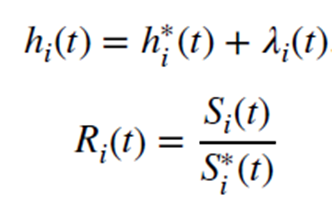
If you’ve been wondering about yoga and its impact on weight loss, you’re not alone. While yoga is primarily known for its calming effects and ability to improve flexibility, many people are curious about its potential in helping to shed those extra pounds.
The answer, in short, is a resounding yes — yoga can indeed support weight management. Here’s how the effort you apply on the yoga mat can help you shed pounds.
What Are the Different Types and Styles of Yoga?
Yoga, having evolved over thousands of years, comes with an array of styles and practices, each providing unique experiences and wellness benefits. Knowing the different styles of yoga allows you to explore and find the one that best serves your health and wellness goals.
Remember, there’s no right or wrong style — there’s only what’s right for you. Let’s dive into exploring some of the most popular forms of yoga so you can find which one might best suit you on your wellness journey.
Hatha Yoga
Hatha yoga, often considered the foundation of many other yoga styles, incorporates a mix of physical postures, breathing exercises, and meditation. Ideal for beginners, Hatha yoga introduces the basic yoga postures (known as asanas) and various breathing techniques.
A typical Hatha class includes poses such as mountain pose (tadasana), downward-facing dog (adho mukha svanasana), and the tree pose (vrikshasana), all aimed at aligning the body and calming the mind. The beauty of Hatha lies in its versatility, making it a wonderful introduction to the world of yoga.
Vinyasa Yoga
Vinyasa yoga offers a dynamic and challenging experience. The word “Vinyasa” literally translates to “connection,” representing the seamless flow between movement and breath.
This style includes a variety of poses, often working towards a peak posture. Common sequences in a Vinyasa class, like the sun salutation (surya namaskar), activate the cardiovascular system to get the heart pumping and the muscles working. If you’re someone who appreciates rhythm and fluidity, Vinyasa might be your perfect yoga match.
Ashtanga Yoga
Given its vigorous and fast-paced nature, Ashtanga yoga is often for those looking for an intense workout that combines aerobic exercise and strength training. The practice combines synchronized breathing with a progressive and exact series of postures.
Each Ashtanga series, six in total, involves a specific sequence of poses that unlock new levels of strength, flexibility, and balance. If you enjoy a structured routine and a solid sweat, Ashtanga might spruce up your wellness routine.
Bikram Yoga
Bikram yoga, founded by Bikram Choudhury in the late 20th century, involves a specific series of 26 postures and two breathing exercises performed in a heated room. The heat stimulates circulation, aids in detoxification, and softens the muscles for improved flexibility.
If you’re cozy with a little heat and enjoy consistent practice, stepping into a Bikram class might feel like coming home.
Restorative Yoga
In contrast to “power yoga” and more intense styles, restorative yoga is slow-paced, designed to relax your muscles deeply and calm your mind. This type of yoga often incorporates props like bolsters, blankets, and blocks to fully support the body in each pose.
You’ll find poses like child’s pose (balasana), corpse pose (savasana), or legs-up-the-wall pose (viparita karani). So, if you’re seeking to reduce stress and create balance in your hectic life, then restorative yoga might just be the tranquil oasis you need.
How Can Yoga Poses and Practice Help With Weight Loss?
Yoga is a holistic physical activity that’s not only about reducing stress and improving flexibility; it can also be a supportive factor in crafting a healthier lifestyle to support your weight loss journey. There’s sound science behind this claim, and here’s a closer look at why yoga can be a great ally in weight management.
Stress Management
Yoga is renowned for its mental health benefits and stress-reducing capabilities. As you practice yoga, you indulge in mindfulness and deep breathing, lowering your cortisol levels, a hormone often linked to stress.
Why does this matter, you ask? Well, chronic stress can often trigger cravings for unhealthy food choices, specifically for high-sugar, high-fat foods, ultimately leading to weight gain and increased body fat. Thus, a regular yoga practice can help keep these cravings in check.
Muscle Building
Many underestimate yoga as they view other forms of exercise as superior tools for building muscle. However, holding various yoga poses requires strength and endurance, leading to increased muscle tone. Certain yoga poses (more on these later) engage major muscle groups and help you build muscle.
As you gradually build lean muscle mass, your body starts to burn calories more efficiently, helping you lose weight easier.
Thermogenic Effect
Certain styles of yoga, like Vinyasa or Bikram, can be fairly physically intense. These styles are cardio-centric and elevate your heart rate to challenge your stamina and endurance, making your body work harder to cool itself down.
As a result of this thermogenic effect, your body increases its energy expenditure during and after your workout, further supporting weight loss.
Mindful Eating
Yoga’s mindfulness aspect also contributes to weight loss. Yoga heightens awareness of your body’s needs, helping you distinguish between true hunger and emotional cravings.
With this mind-body connection, it becomes easier to make better eating decisions, steering you towards healthier choices.
What Are the Best Yoga Poses for Weight Loss?
Starting your journey into the world of yoga may seem daunting, but the key is to take one step at a time. Let’s start with a close look at three fundamental yet effective poses that can build strength, enhance stamina, support toning, and help you lose weight.
Plank Pose
Plank pose, or kumbhakasana, seriously challenges your abdominals, shoulders, and arms, making it a full-body workout in itself.
- Begin in a tabletop position with your hands directly under your shoulders and knees under your hips.
- Extend your legs behind you, coming onto the balls of your feet. Make sure your body is in a straight line from head to feet.
- Engage your core and hold the pose for 30 seconds to begin with, gradually building up your endurance.
Warrior II
Warrior II, or virabhadrasana II, enhances balance and stamina while toning your leg muscles, glutes, obliques, and shoulders.
- Start with your feet hip-width apart and take a big step back with your right foot, turning it out to about 90 degrees.
- Extend your arms parallel to the floor and bend your front knee, making sure it’s directly above your ankle.
- Turn your head towards your left hand and hold the pose for 30 seconds to a minute before switching sides.
Boat Pose
Boat Pose, or navasana, is an excellent core strengthener as it targets your abs, hip flexors, and spine, promoting a strong core and improved balance.
- Start in a seated position with your knees bent and feet flat on the floor.
- Lean back slightly while lifting your feet off the floor, bringing your shins parallel to the ground.
- Extend your arms in front of you parallel to the ground, and if possible, straighten your legs. This forms a “V” shape with your body.
- Hold for about 30 seconds, engaging your abdominals throughout.
Remember, these poses can be modified to suit your capabilities and fitness level. For instance, in a plank pose, you can drop your knees to the floor for a less intense version.
The key to seeing results with yoga is consistency. Just like brushing our teeth or eating healthful meals, making yoga a regular part of your routine is essential for the best results.
As you progress, you’ll notice improved strength and flexibility along your weight loss journey.
What’s Better: Yoga Classes or Personal Trainer?
As a beginner venturing into the world of yoga, the decision between joining yoga classes and hiring a personal trainer can indeed be overwhelming. Each offers unique benefits and presents certain challenges. Here’s a deeper dive to help guide your decision.
Yoga Classes
Yoga classes offer a sense of community and shared experience. In such group settings, you can learn from others, gain support, and celebrate collective progress.
Pros
- Community feel: This option enables mutual motivation and a shared journey towards wellness.
- Variety: Different yoga instructors may bring unique styles and techniques, keeping classes diverse.
- Affordability: This is a more cost-effective option, with unlimited monthly packages available in most studios.
Cons
- Less personal attention: Large group sizes might limit personalized feedback.
- Fixed schedules: Class times may not always align perfectly with your personal schedule.
- Learning pace: You might have to keep up with the group pace, which could be challenging for true beginners.
Personal Trainer
A personal trainer provides individualized attention, tailoring the sessions based on your capabilities, goals, and preferences.
Pros
- Personalized attention: Sessions tailored to your abilities ensure a progressive and safe learning path.
- Flexible schedule: You can plan your sessions at a time that suits your routine.
- Constant monitoring: With one-on-one attention, you can receive regular feedback on your posture, alignment, and progress.
Cons
- Cost: Personal trainers typically come at a higher cost than group classes.
- Lack of community feel: One-on-one sessions might lack the motivating group energy that classes can offer.
In the end, whether you choose yoga classes or a personal trainer depends significantly on your personal comfort, convenience, and budget. Consider your goals, learning style, and availability before making a decision.
Remember, the ultimate goal is enhancing your health and wellness, so choose the option that will best motivate you to show up on your mat regularly.
How Can You Incorporate Yoga Into a Weight Loss Routine?
Incorporating yoga into your weight loss routine is quite simple. You can start by dedicating a couple of sessions each week to yoga.
Gradually increase the frequency as your body adjusts. Consider starting your day with a short yoga session — it can be a great way to kick-start your metabolism and set a positive tone for the day.
Creating a Yoga Routine
Developing an effective yoga routine, much like building a healthy lifestyle, is a matter of consistency, personal preference, and self-awareness. To start with, the routine doesn’t have to be time-consuming or extensive — even 15 to 20 minutes a day of dedicated yoga practice can bring noticeable changes.
Let’s look at some points to remember:
- Regularity: Consistent daily practice will yield more benefits than occasional lengthy sessions. A little yoga each day can contribute to flexibility, strength, and mental serenity.
- Personalization: Choose yoga poses that resonate with your fitness level, comfort, and specific goals. It’s better to excel in a few essential poses than hurriedly rushing through a long sequence.
- Self-awareness: It’s essential to listen to your body. If a certain pose causes discomfort, it’s okay to make modifications or use props. Also, remember to relax and breathe during your practice.
Choosing the Right Yoga Style
The beauty of yoga is its diversity. Each style caters to different levels of fitness and goals.
Here are a few things to keep in mind when choosing your yoga style:
- Weight loss focus: Power-packed styles like Vinyasa or Ashtanga can boost your metabolism and aid in weight loss. They involve continuous, fluid movements and can be quite aerobic.
- Relaxation and toning: If your goal is to relax your mind and still get a mild workout, then Hatha or restorative yoga are excellent options. They focus on gentle, slow poses held for extended periods, offering toning benefits.
Pairing Yoga With Nutrition
Just as yoga nourishes your mind and body at the spiritual level, it’s essential to nourish yourself on the physical level, too. A balanced diet is the perfect partner to your yoga regimen.
Healthy eating habits, such as getting plenty of fruits, vegetables, lean proteins, and whole grains, provide the energy for your yoga practice and keep you satiated. Bone broth can especially be beneficial, as this traditional, savory liquid is low in calories and high in vitamins and minerals.
It’s also essential that you remember to stay hydrated. Water plays a crucial role in supporting your metabolism and can assist in managing your appetite. Drinking a glass of water before your yoga practice can help you stay replenished and ensure your body has what it needs to function properly.
The Bottom Line
With its focus on mindfulness, stress reduction, and physical toning, yoga can indeed be an effective tool for weight management. When combined with a nutrient-rich diet, its benefits are enhanced, supporting overall health and wellness.
So whether you’re a seasoned yogi or new to the club, whether your goal is weight loss or simply enhancing physical and mental well-being, yoga has something valuable to offer. Make it a part of your daily routine, and you’ll soon see the difference.
And remember, while genetics have their influence, they are not destiny. You have the power to shape your future. Embrace yoga as a supportive companion in your wellness journey, and you’ll be amazed at your body’s capacity to transform.
As you embark on this wellness journey, we’re here to help. Dr. Kellyann has a collection of low-carb recipes, health tips, and protein-packed products that can give you what you need to shape your health journey.
Sources:
Yoga: What You Need To Know | NCCIH
7 Different Kinds of Yoga and How To Find the Right Practice | Cleveland Clinic
Does Yoga Build Muscle? | Live Science
Long-Term Effect of Yogic Practices on Diurnal Metabolic Rates of Healthy Subjects | PMC
Mindful Eating: The Art of Presence While You Eat | PMC
Study Sees Beneficial Role of Yoga in Weight-Loss Program for Adults With Obesity or Overweight | NCCIH





